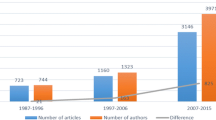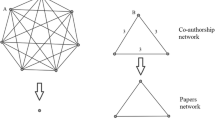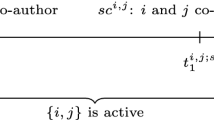Abstract
This exploratory work sheds light on important functional information characteristics of the system of research collaboration by examining large-scale topological structures of co-authorship networks, created through the affiliative ties of scholarly articles published by collaborating researchers in peer-reviewed journals and conference proceedings. The model adopted in this work to understand the underlying collaboration system incorporates the strengths of collaborative coupling among the researchers. The questions we examine in this work are as follows: (1) What new functional characteristics emerge when combined structural effects of collaborative coupling and large-scale connectivity exist in the networks? (2) What information does a specific closeness distribution of collaborating researchers convey with regard to the flow of knowledge through collaborative activities? (3) What is the temporal dynamics of large-scale structure formation in these networks? The work involves a comparative study of these characteristics using the networks of two countries: India and the US. Our results have important implications for scientometric studies of collaboration research.


























Similar content being viewed by others
Notes
We used the subject category Business Management and Accounting for Scopus. For WoS, we used the category operations research, management science, management, economics, business, and business finance.
The selection of the time window was not motivated by any financial or political events in the US or in India. The time horizon of this study was a period when the MGMT field was actively growing in both countries. We did retrieve some earlier data (from the 80s and the 90s), but they turned out to be either incomplete in indexing or insufficient in volume in either one or the other of the databases to provide reliable statistical estimates of the quantities of interest in this study.
A giant cluster of researchers is a connected cluster containing the largest number of researchers in the network. Commonly, it is called giant, when the concerned network operates in the percolating regime (Newman 2001a).
There may be more than one of these.
Still shorter periods using data over 4 or 6 months are theoretically possible, but the journal listings in the actual databases are incompletely indexed over such short periods.
We thank a reviewer for raising this point.
The Epanechnikov kernel is used to compute the density (Greene 2002).
Many senior researchers are also known to quit research in order to accept administrative roles.
Such a section has both high transitivity as well as a large coupling strength.
Interestingly, a disparity analysis has been used to identify some dominant reactions in metabolic networks (Almaas et al. 2004).
We thank a reviewer for raising this interesting question regarding the merging of the two datasets created from two separate databases. Unfortunately, we have not encountered any references in the literature where this has actually been performed in the network construction process.
We thank a reviewer for pointing it out to us.
We thank a reviewer for raising this point.
References
Acedo, F. J., Barroso, C., Casanueva, C., & Galán, J. L. (2006). Co-authorship in management and organizational studies: An empirical and network analysis. Journal of Management Studies, 43(4), 957–983.
Ahuja, G. (2000). Collaboration networks, structural holes, and innovation: A longitudinal study. Administrative Science Quarterly, 45(3), 425–455.
Aldrich, H. E., & Kim, P. H. (2007). Small worlds, infinite possibilities? How social networks affect entrepreneurial team formation and search. Strategic Entrepreneurship Journal, 1(2), 147–165.
Almaas, E., Kovács, B., Vicsek, T., Oltvai, Z. N., & Barabási, A.-L. (2004). Global organization of metabolic fluxes in the bacterium Escherichia coli. Nature, 427, 839–843.
Barabási, A.-L., Jeong, H., Ravasz, R., Néda, Z., Vicsek, T., & Schubert, A. (2002). On the topology of the scientific collaboration networks. Physica, 311, 590–614.
Barthélemy, M., Barrat, A., Pastor-Satorras, R., & Vespignani, A. (2005). Characterization and modeling of weighted networks. Physica A, 346(1–2), 34–43.
Batagelj, V., Mrvar, A., & Zaveršnik, M. (2012). Obtained from http://pajek.imfm.si/doku.php. Accessed 2 Jan 2014.
Bossomaier, T. (2014). Language networks. In R. Stocker & T. Bossomaier (Eds.), Networks in Society. Links and Language (pp. 49–80). Florida: CRC Press.
Bozeman, B., & Corley, E. (2004). Scientists’ collaboration strategies: implications for scientific and technical human capital. Research Policy, 33(4), 599–616.
Callaway, D. S., Newman, M. E. J., Strogatz, S. H., & Watts, D. J. (2000). Network robustness and fragility: Percolation on random graphs. Physical Review Letters, 85(25), 5468–5471.
CMS. (2012). Observation of a new boson at a mass of 125 GeV with the CMS experiment at the LHC. Physics Letters B, 716(1), 30–61.
Cummings, J. N., & Kiesler, S. (2005). Collaborative research across disciplinary and organizational boundaries. Social Studies of Science, 35(5), 703–722.
Dahlander, L., & McFarland, D. A. (2013). Ties that last: Tie formation and persistence in research collaborations over time. Administrative Science Quarterly, 58(1), 69–110.
Fleming, L., Mingo, S., & Chen, D. (2007). Collaborative brokerage, generative creativity, and creative success. Administrative Science Quarterly, 52, 443–475.
Freeman, L. C. (1979). Centrality in social networks: I.Conceptual clarification. Social Networks, 1, 215–239.
Ghosh, J., & Kshitij, A. (2014). An integrated examination of collaboration co-authorship networks through structural cohesion, holes, hierarchy, and percolating clusters. Journal of the American Society for Information Science and Technology, 65(8), 1639–1661.
Giddens, A. (1979). Central Problems in Social Theory: Action, Structure, and Contradiction in Social Analysis. California: University of California Press.
Granovetter, M. S. (1973). The strength of weak ties. American Journal of Sociology, 78(6), 1360–1380.
Greene, W. H. (2002). Econometric analysis. NJ: Prentice-Hall.
Hara, N., Solomon, P., Kim, S.-L., & Sonnenwald, D. H. (2003). An emerging view of scientific collaboration: Scientists’ perspectives on collaboration and factors that impact collaboration. Journal of the American Society for Information Science and Technology, 54(10), 952–965.
Haythornthwaite, C. (2006). Learning and knowledge networks in interdisciplinary collaborations. Journal of the American Society for Information Science and Technology, 57(8), 1079–1092.
Kang, I.-S., Na, S.-H., Lee, S., Jung, H., Kim, P., Sung, W.-K., et al. (2009). On co-authorship for author disambiguation. Information Processing and Management, 45(1), 84–97.
Kshitij, A., Ghosh, J., & Gupta, B. M. (2014). Embedded information structures and functions of co-authorship networks: Evidence from cancer research collaboration in India. Scientometrics. doi: 10.1007/s11192-014-1310-y.
Kumar, S., & Jan, J. M. (2014). Research collaboration networks of two OIC nations: Comparative study between Turkey and Malaysia in the field of ‘Energy Fuels’, 2009–2011. Scientometrics, 98(1), 387–414.
Lozano, S., Rodríguez, X.-P., & Arenas, A. (2014). Atapuerca: Evolution of scientific collaboration in an emergent large-scale research infrastructure. Scientometrics, 98(2), 1505–1520.
Melin, G., & Persson, O. (1996). Studying research collaboration through co-authorships. Scientometrics, 36(3), 363–377.
Milojević, S. (2013). Accuracy of simple, initials-based methods for author name disambiguation. Journal of Informetrics, 7(4), 767–773.
Morais, A. S., Olsson, H., & Schooler, L. J. (2013). Mapping the structure of semantic memory. Cognitive Science, 37(1), 125–145.
Newman, M. E. J. (2001a). The structure of scientific collaboration networks. Proceedings of the National Academy of Sciences, 98(2), 404–409.
Newman, M. E. J. (2001b). Scientific collaboration networks. I. Network construction and fundamental results. Physical Review E, 64, 016131-1–016131-8.
Newman, M. E. J. (2001c). Scientific collaboration networks. II. Shortest paths, weighted networks, and centrality. Physical Review E, 6, 016132-1–016132-7.
Newman, M. E. J. (2004). Analysis of weighted networks. Physical Review E, 70, 056131-1–056131-9.
Newman, M. E. J., & Watts, D. J. (1999). Scaling and percolation in the small-world model. Physical Review E, 60(6), 7332–7342.
Oh, W., Choi, J. N., & Kim, K. (2006). Coauthorship dynamics and knowledge capital: The patterns of cross-disciplinary collaboration in information systems research. Journal of Management Information Systems, 22(3), 266–292.
Ozel, B. (2012). Collaboration structure and knowledge diffusion in Turkish management academia. Scientometrics, 93(1), 183–206.
Porter, A. L., & Rafols, I. (2009). Is science becoming more interdisciplinary? Measuring and mapping six research fields over time. Scientometrics, 81(3), 719–745.
Press, W. H., Teukolsky, S. A., Vetterling, W. T., & Flannery, B. P. (1992). Numerical Recipes in C. The Art of Scientific Computing. New York: Cambridge University Press.
Rafols, I., & Meyer, M. (2010). Diversity and network coherence as indicators of interdisciplinarity: Case studies in bionanoscience. Scientometrics, 82(2), 263–287.
Roessner, D., Porter, A. L., Nersessian, N. J., & Carley, S. (2013). Validating indicators of interdisciplinarity: Linking bibliometric measures to studies of engineering research labs. Scientometrics, 94(2), 439–468.
Sabidussi, G. (1966). The centrality index of a graph. Psychometrika, 31, 581–603.
Scopus (2012). Obtained from Elsevier at http://www.info.sciverse.com/scopus. Accessed 5 July 2013.
Scott, J. (2000). Social Network Analysis: A Handbook. London: Sage Publications.
Sedgewick, R., & Wayne, K. (2011). Algorithms. Upper Saddle River, NJ: Addison-Wesley.
Shrum, W., Genuth, J., & Chompalov, I. (2007). Structures of Scientific Collaboration. Cambridge, MA: MIT Press.
Sonnenwald, D. H. (2007). Scientific Collaboration. Annual Review of Information Science and Technology, 41(1), 643–681.
Uzzi, B., & Spiro, J. (2005). Collaboration and creativity: The small world problem. American Journal of Sociology, 111(2), 447–504.
Wagner, C. S., Roessner, J. D., Bobb, K., Klein, J. T., Boyack, K. W., Keyton, J., et al. (2011). Approaches to understanding and measuring interdisciplinary scientific research (IDR): A review of the literature. Journal of Informetrics, 5(1), 14–26.
Wasserman, S., & Faust, K. (1994). Social Network Analysis. Cambridge: Cambridge University Press.
Watts, D. J. (1999). Networks, dynamics, and the small-world phenomenon. American Journal of Sociology, 105(2), 493–527.
Watts, D. J., & Strogatz, S. H. (1998). Collective dynamics of ‘small-world’ networks. Nature, 393, 440–442.
Web of Science (2012). Obtained from Thomson Reuters at http://thomsonreuters.com/products_services/science/science_products/a-z/web_of_science. Accessed 5 July 2013.
Acknowledgments
The authors wish to acknowledge three anonymous reviewers of Scientometrics for suggesting a number of improvements in the paper. Thanks are also due to Dr. P. Banerjee, Director of CSIR–NISTADS, for helpful comments on an early version of the paper. Jaideep Ghosh would like to thank the Department of Science & Technology, Government of India, for financial support to carry out this work.
Author information
Authors and Affiliations
Corresponding author
Rights and permissions
About this article
Cite this article
Ghosh, J., Kshitij, A. & Kadyan, S. Functional information characteristics of large-scale research collaboration: network measures and implications. Scientometrics 102, 1207–1239 (2015). https://doi.org/10.1007/s11192-014-1475-4
Received:
Published:
Issue Date:
DOI: https://doi.org/10.1007/s11192-014-1475-4




